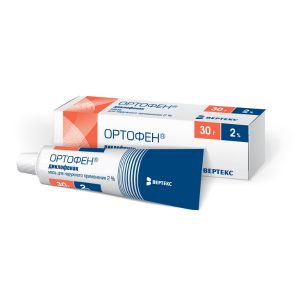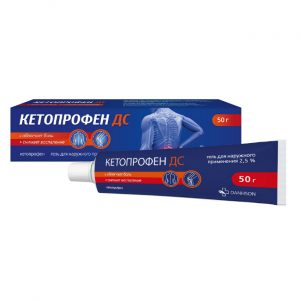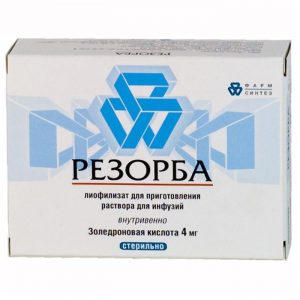Description
Latin name
diclofenac
Release form
Gel for external use 1%.
40 g of gel per aluminum tube, sealed with a screw cap made of plastic. The tube opening is protected by an aluminum membrane. The cap is a monolithic structure, including a device for piercing the membrane. The tube, along with instructions for use, is placed in a cardboard pack.
Pharmacological action
A non-steroidal anti-inflammatory drug derived from phenylacetic acid has an anti-inflammatory and analgesic effect. Indirectly inhibiting cyclooxygenase 1 (COX1) and cyclooxygenase 2 (COX2), affects the metabolism of arachidonic acid, reduces the amount of prostaglandins (Pg) in the focus of inflammation.
Pharmacokinetics
When applied topically, it is partially absorbed through the skin, bioavailability is 6%. Communication with plasma proteins – 99.7%. It is excreted by the kidneys. In patients with polyarthritis, who receive local therapy (in the area of the inflamed joint), the concentration in the synovial fluid and tissue is higher than the concentration in the plasma.
Indications
Inflammatory and degenerative diseases of the musculoskeletal system (rheumatoid arthritis, psoriatic, juvenile chronic arthritis, ankylosing spondylitis, rheumatic soft tissue lesions gouty arthritis) traumatic inflammation of the tendons, ligaments in the joints and muscles and joints and joints )
Contraindications
Hypersensitivity to diclofenac or other components of the drug, acetylsalicylic acid or other NSAIDs. Complete or incomplete combination of bronchial asthma, recurrent polyposis of the nose and paranasal sinuses and intolerance to acetylsalicylic acid or other NSAIDs (history). Pregnancy (III trimester), lactation, children’s age (up to 12 years), violation of the integrity of the skin.
With caution
Hepatic porphyria (exacerbation), erosive and ulcerative lesions of the gastrointestinal tract (in the exacerbation phase), severe impaired liver and kidney function, chronic heart failure, impaired blood coagulation (including hemophilia, prolonged bleeding time, tendency to bleeding) bronchial asthma, advanced age, pregnancy I and II trimester.
Special instructions
Gel is applied only to intact skin. After application, an occlusive dressing should not be applied.
When applied to large skin surfaces for a long time, the risk of developing systemic side effects increases.
Avoid contact with eyes, mucous membranes, or open wounds. Use only as an external agent.
Composition
1 gel gel 10 mg gel 10 mg gel 10 mg gel substances – isopropanol, carbomer 940, polysorbate 80, benzyl alcohol, sodium disulfite, sorbitol, trolamine, purified water.
Dosage and Administration
Externally. For adults and children over 12 years of age, the drug is applied a thin layer over the focus of inflammation 3-4 times a day and rubbed lightly. The required amount of the drug depends on the size of the painful area. A single dose of the drug: 2 to 4 g (which is comparable in volume to the size of a large cherry).
After applying the drug, wash your hands.
The duration of treatment depends on the indications and therapeutic effect. After 2 weeks of using the drug, consult your doctor.
Side effects
For the skin: eczema, photosensitivity, contact dermatitis (itching, hyperemia, puffiness of the treated area of the skin, papular vesicular eruptions, peeling).
Allergic reactions (itching and burning of the skin, erythematous skin rash, urticaria, angioedema, systemic anaphylactic reactions (including shock).
Drug interaction
With the simultaneous use of the drug Diclofenac with digoxin, with phenytoin or lithium drugs, it is possible to increase the plasma concentrations of these drugs with diuretics and antihypertensive drugs – it is possible to decrease the effect of these drugs with potassium-sparing diuretics – it is possible to develop hyperkalemia with acetisalicylic acid – a decrease in the concentration of diclofenac in blood plasma and an increased risk of side effects.
Diclofenac may enhance the toxic effects of cyclosporine on the kidneys.
Diclofenk can cause hypo- or hyperglycemia, therefore, when used simultaneously with hypoglycemic agents, monitoring of blood glucose concentration is required.
When methotrexate is used within 24 hours before or after taking Diclofenac, an increase in the concentration of methotrexate and an increase in its toxic effect are possible.
With simultaneous use with anticoagulants, regular monitoring of blood coagulation is necessary.
Storage Conditions
At 15 to 25 ° C.
Keep out of the reach and sight of children!
Expiration
3 years.
active substance
Diclofenac
Terms leave through pharmacies
without prescription
Dosage form
gel for external use




